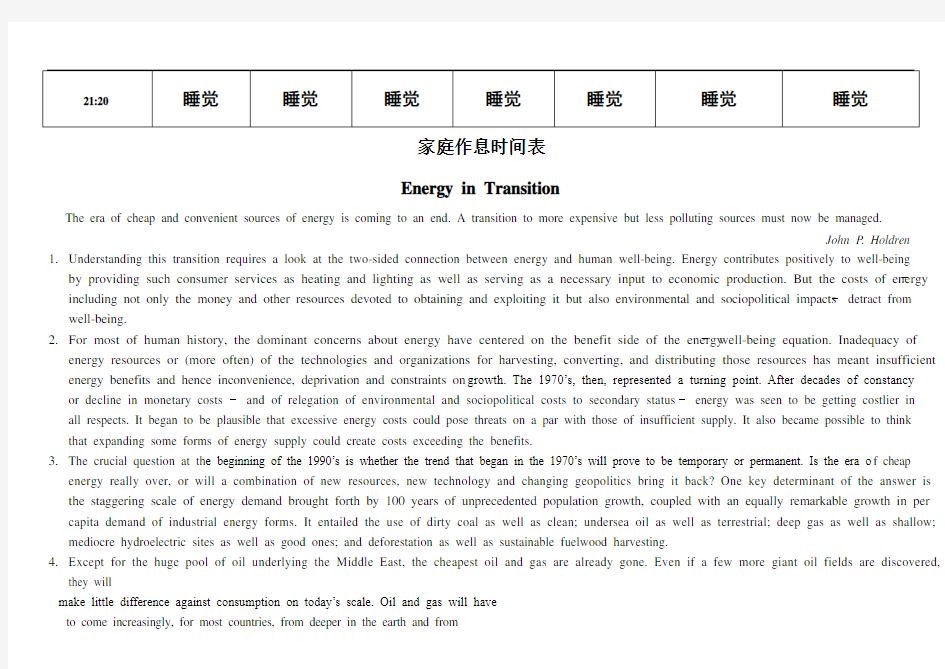最新小学三年级作息时间


家庭作息时间表
Energy in Transition
The era of cheap and convenient sources of energy is coming to an end. A transition to more expensive but less polluting sources must now be managed.
John P. Holdren 1.Understanding this transition requires a look at the two-sided connection between energy and human well-being. Energy contributes positively to well-being
by providing such consumer services as heating and lighting as well as serving as a necessary input to economic production. But the costs of energy -including not only the money and other resources devoted to obtaining and exploiting it but also environmental and sociopolitical impacts - detract from well-being.
2.For most of human history, the dominant concerns about energy have centered on the benefit side of the energy - well-being equation. Inadequacy of
energy resources or (more often) of the technologies and organizations for harvesting, converting, and distributing those resources has meant insufficient energy benefits and hence inconvenience, deprivation and constraints on growth. The 1970’s, then, represented a turning point. After decades of constancy or decline in monetary costs - and of relegation of environmental and sociopolitical costs to secondary status - energy was seen to be getting costlier in all respects. It began to be plausible that excessive energy costs could pose threats on a par with those of insufficient supply. It also became possible to think that expanding some forms of energy supply could create costs exceeding the benefits.
3.The crucial question at th e beginning of the 1990’s is whether the trend that began in the 1970’s will prove to be temporary or permanent. Is the era o f cheap
energy really over, or will a combination of new resources, new technology and changing geopolitics bring it back? One key determinant of the answer is the staggering scale of energy demand brought forth by 100 years of unprecedented population growth, coupled with an equally remarkable growth in per capita demand of industrial energy forms. It entailed the use of dirty coal as well as clean; undersea oil as well as terrestrial; deep gas as well as shallow;
mediocre hydroelectric sites as well as good ones; and deforestation as well as sustainable fuelwood harvesting.
4.Except for the huge pool of oil underlying the Middle East, the cheapest oil and gas are already gone. Even if a few more giant oil fields are discovered,
they will
make little difference against consumption on today’s scale. Oil and gas will have
to come increasingly, for most countries, from deeper in the earth and from
imports whose reliability and affordability cannot be guaranteed.
5.There are a variety of other energy resources that are more abundant than oil and gas. Coal, solar energy, and fission and fusion fuels are the most important
ones. But the y all require elaborate and expensive transformation into electricity or liquid fuels in order to meet society’s needs. None has very good prospects for delivering large quantities of electricity at costs comparable to those of the cheap coal-fired and hyd ropower plants of the 1960’s. It appears, then, that expensive energy is a permanent condition, even without allowing for its environmental
